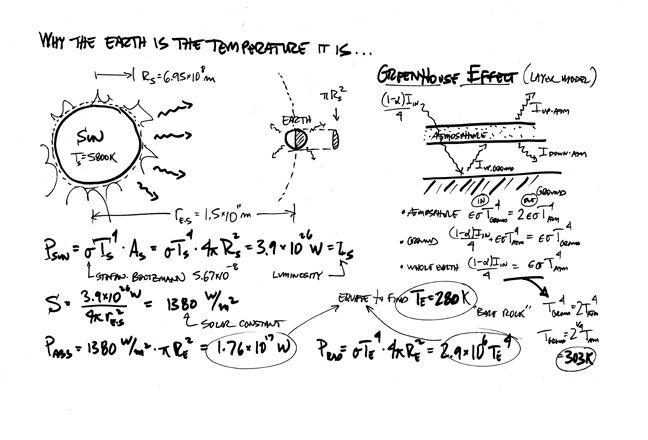Why the Earth's Temperature Is What It Is

Professor Michael Brown's formula for why the Earth is the temperature it is. (Click image to see detail.)
In his first-year seminar titled Energy, Professor Michael Brown’s explanation of the Earth’s temperature begins by calculating the Sun’s radius (Rs), the distance from Sun to Earth (rE-S), and the cross-sectional area of the circle of solar energy that is intercepted by Earth’s surface.
Equations below the diagram show the derivation of the Sun’s luminosity—its total power output—from its surface temperature (Ts) and size (Rs) using the Stefan-Boltzmann Law. At its surface, the sun gives off 3.9 x 1026 watts—one very bright bulb!
The next equation shows how this power is diluted by distance as this “bubble” of energy expands outward from the Sun. The power density at the surface of a bubble the radius of the Earth’s orbit is measured in watts per square meter; it is known as the Solar Constant, and is calculated at 1380 W/m2.
Using the Solar Constant and the cross-sectional area that this energy falls on, Brown shows that the power absorbed by the Earth (PABS) totals 1.76 x 1017 W. But because Earth also radiates energy, Brown factors in this loss to the system (PRAD) and equates the two values to arrive at a temperature for a “bare rock”
Earth (TE) of 280K. Pretty chilly for us warm-blooded humans!
Fortunately, there’s the greenhouse effect. The Earth’s atmosphere acts like a thin layer of glass that reflects back some of the energy radiated by the Earth. Thus, the planet has two energy inputs—one from the Sun and one from the Earth itself—that combine to raise the temperature to a habitable 303K. Just about right—unless we mess with the reflective capacity of the atmosphere.
 Email This Page
Email This Page